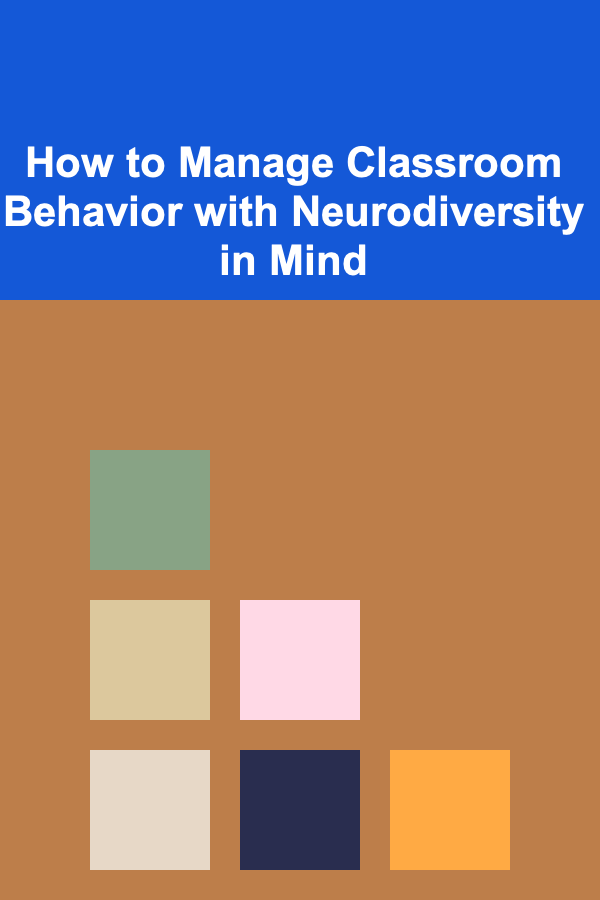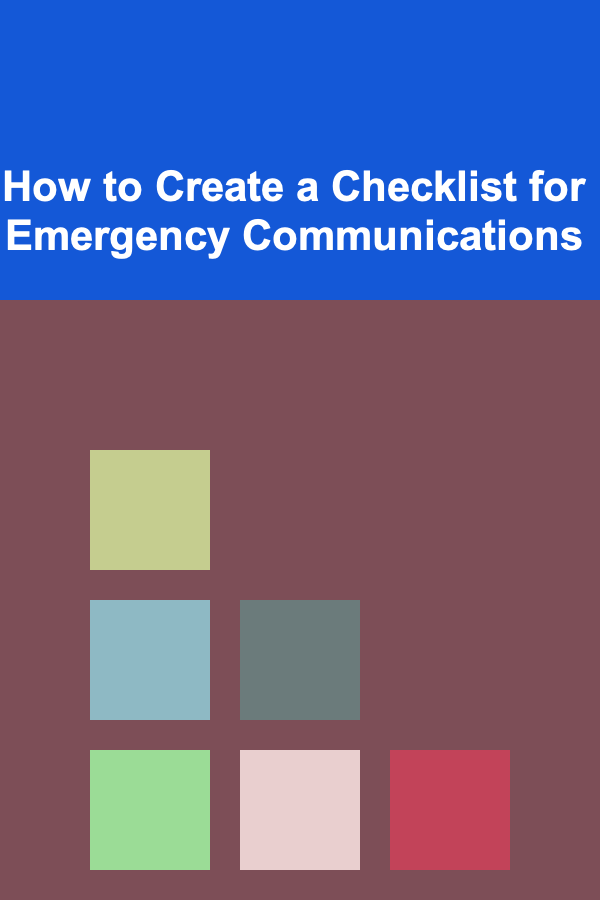
How to Manage Classroom Behavior with Neurodiversity in Mind
ebook include PDF & Audio bundle (Micro Guide)
$12.99$9.99
Limited Time Offer! Order within the next:

As educators, understanding the diversity in our classrooms is paramount. Students come from varied backgrounds and have distinct learning needs, and neurodiversity is one of the key elements that must be considered when managing classroom behavior. Neurodiversity refers to the natural variations in the human brain and its functioning, and it encompasses conditions such as autism spectrum disorder (ASD), ADHD (Attention Deficit Hyperactivity Disorder), dyslexia, and other cognitive and developmental differences. These conditions can significantly affect a student's behavior, communication, social skills, and ability to process information.
In this article, we will explore the importance of managing classroom behavior with neurodiversity in mind. We will dive into strategies that not only create an inclusive and supportive environment for neurodiverse students but also foster a positive and effective classroom dynamic for all learners.
Understanding Neurodiversity
Before diving into strategies, it's important to have a solid understanding of what neurodiversity is. Neurodiversity emphasizes the idea that differences in brain functioning are not deficits, but rather part of the natural variation of human beings. People who are neurodiverse may have conditions such as:
- Autism Spectrum Disorder (ASD): A developmental condition characterized by challenges with social interaction, communication, and behavior. Individuals with ASD may also have specific strengths, such as attention to detail and strong memory skills.
- Attention Deficit Hyperactivity Disorder (ADHD): A condition marked by symptoms of inattention, hyperactivity, and impulsivity. Students with ADHD may struggle with focus, sitting still, and following instructions.
- Dyslexia: A learning difference affecting reading, spelling, and writing. Students with dyslexia may have difficulty decoding words and comprehending written text, despite often having average or above-average intelligence.
- Dyspraxia (Developmental Coordination Disorder): A condition affecting motor coordination, which can make tasks such as writing, tying shoelaces, or participating in physical activities challenging.
- Sensory Processing Disorder: A condition in which the brain has difficulty receiving and responding to sensory input, such as touch, sound, or visual stimuli.
The Importance of Neurodiversity in the Classroom
Recognizing and respecting neurodiversity in the classroom benefits both neurodiverse students and their peers. By fostering an inclusive environment, educators create a space where all students can thrive academically, socially, and emotionally. When educators embrace neurodiversity, they allow for a deeper understanding of their students' needs and better manage behavior in the classroom.
Benefits of Neurodiversity Awareness:
- Promotes Inclusion: When teachers understand the needs of neurodiverse students, they can create more inclusive lesson plans, seating arrangements, and activities that cater to a variety of learning styles.
- Reduces Misunderstandings: Many behavioral issues arise from a lack of understanding. When teachers are aware of the neurodiverse needs of their students, they are less likely to misinterpret behavior as defiance or laziness.
- Builds Empathy and Social Skills: Neurodiverse students can serve as an example of how differences should be respected and celebrated. This not only builds empathy among classmates but also fosters social cohesion in the classroom.
- Enhances Student Engagement: Understanding how neurodiverse students learn best allows educators to adapt their teaching methods, making the material more engaging and accessible for all students.
Effective Strategies for Managing Classroom Behavior
Managing classroom behavior with neurodiversity in mind requires flexibility, creativity, and patience. Here are several strategies that can help teachers create a supportive and positive learning environment for all students.
1. Establish Clear Expectations and Routines
Students with neurodiverse conditions, such as ADHD or ASD, often thrive in structured environments where expectations and routines are clearly defined. Establishing consistent classroom rules and routines helps students feel secure and reduces anxiety.
- Set Clear Expectations: Clearly define what behavior is expected in the classroom, and make sure to reinforce these expectations regularly. Visual reminders of rules can be especially helpful for students with ADHD or autism.
- Create Visual Schedules: Use visual schedules to outline the day's activities. This can be particularly helpful for neurodiverse students who may struggle with transitions or changes in routine.
- Routine Reinforcement: Reinforce routines by incorporating them into daily practices. For example, start and end each lesson with a predictable ritual (like a song or a countdown) to help students transition smoothly.
2. Provide Sensory Breaks
For students with sensory processing issues or ADHD, long periods of classroom activity can be overwhelming. Sensory breaks give students a chance to reset and return to their work with a clearer mind.
- Create Sensory Spaces: Designate a quiet space in the classroom where students can take breaks when feeling overstimulated. Equip this space with calming materials like soft pillows, noise-canceling headphones, or fidget toys.
- Movement Breaks: Incorporate short, active breaks throughout the day. These could include stretching, jumping jacks, or simply walking around the classroom. Movement breaks help to release energy and improve focus.
- Provide Time for Transitions: Transitions between activities can be difficult for neurodiverse students. Giving extra time for transitions or preparing students in advance for upcoming changes can help reduce anxiety and behavioral outbursts.
3. Use Positive Reinforcement
Positive reinforcement is a powerful tool for managing classroom behavior. By acknowledging and rewarding positive behavior, educators encourage students to repeat those actions.
- Reward Systems: Implement reward systems, such as earning points or tokens for completing tasks or demonstrating good behavior. These rewards can be exchanged for preferred activities or items.
- Praise Efforts, Not Just Results: It's essential to praise the process, not just the outcome. For example, recognize a student's effort in staying on task, even if the result is not perfect. This encourages persistence and boosts self-esteem.
- Use Specific Praise: Be specific in your praise so that students understand exactly what behavior is being rewarded. For instance, instead of saying "Good job," say "I like how you raised your hand before speaking."
4. Offer Clear and Simple Instructions
Students with neurodiverse conditions often struggle with complex instructions or multi-step directions. Offering clear and simple instructions can help them understand and complete tasks more effectively.
- Use Short Sentences: Keep instructions concise and to the point. Avoid lengthy explanations or abstract language.
- Repeat Instructions: Repeat important instructions and provide written reminders or visual cues. Neurodiverse students may need additional time to process verbal instructions.
- Break Tasks into Steps: Break complex tasks into smaller, manageable steps. This reduces overwhelm and helps students focus on one task at a time.
5. Foster Peer Support and Collaboration
Incorporating peer support into classroom activities can help neurodiverse students develop social skills and feel more connected to their peers. Collaboration also encourages empathy and understanding among all students.
- Pair Students with Buddies: Assign neurodiverse students a "buddy" for group work or other activities. Buddies can offer social support, assist with tasks, and encourage engagement.
- Facilitate Group Projects: Group work can provide neurodiverse students with opportunities to practice social skills in a structured setting. Ensure that roles are clearly defined, and encourage students to work together towards a common goal.
- Promote Empathy: Foster a classroom culture where students respect each other's differences. Teach students about neurodiversity through discussions or activities that promote empathy and inclusion.
6. Utilize Technology and Adapted Tools
Technology can be a powerful ally in supporting neurodiverse students. There are many digital tools and resources that can help with learning, communication, and behavior management.
- Use Learning Apps: Apps designed for students with ADHD, autism, or dyslexia can be used to assist with focus, organization, and learning tasks. Apps for reading, writing, and time management can be incredibly helpful.
- Incorporate Audio and Visual Aids: For students who struggle with reading or processing written material, use audio books, videos, or interactive whiteboards to present information in different formats.
- Behavior Tracking Apps: Use apps that allow teachers to track behavior patterns, reward progress, and communicate with parents. These tools can be beneficial for students with ADHD or other conditions that require consistent monitoring and feedback.
7. Be Flexible and Patient
Perhaps one of the most important qualities a teacher can have when managing a neurodiverse classroom is flexibility. Each student is unique, and strategies that work for one student may not be as effective for another.
- Adapt Strategies to Individual Needs: Be willing to modify your approach based on each student's needs and preferences. For example, some students with ADHD may need more frequent breaks, while others may benefit from extended time to complete assignments.
- Practice Patience: Neurodiverse students may require more time to process instructions, complete tasks, or respond to social cues. Practice patience and provide the necessary support to help them succeed.
- Celebrate Progress: Recognize and celebrate even small successes. Every step forward, no matter how small, is important and should be acknowledged.
Conclusion
Managing classroom behavior with neurodiversity in mind requires a deep understanding of the unique challenges and strengths that neurodiverse students bring to the classroom. By creating an inclusive environment, using clear and simple instructions, providing sensory breaks, and offering positive reinforcement, teachers can help all students thrive. The goal is not only to manage behavior but to empower neurodiverse students to develop the skills they need to succeed both academically and socially. By fostering an environment of empathy, support, and respect, educators play a crucial role in shaping the future of these students and helping them reach their full potential.
Reading More From Our Other Websites
- [Organization Tip 101] How to Create a Comfortable and Ergonomic Workspace
- [Gardening 101] The Secrets of Bokashi Composting: Fermenting Food Waste Indoors
- [Personal Financial Planning 101] How to Build Passive Income Streams for Financial Security
- [Biking 101] Top 5 Vintage Bikes Every Enthusiast Should Own
- [Home Budget Decorating 101] How to Create a Functional and Stylish Home Office on a Budget
- [Personal Care Tips 101] How to Use Body Wash to Hydrate Dry Skin
- [Personal Care Tips 101] How to Ensure a Smooth Shave with Personal Care Tips
- [Personal Investment 101] How to Use ETFs for Low-Cost Investment Growth
- [Organization Tip 101] How to Develop a Sustainable Maintenance Plan
- [Organization Tip 101] How to Create a Digital Gallery for Kids' Art Projects

How to Create a Checklist for Emergency Communications
Read More
How to Keep Your Home's Air Quality at Its Best
Read More
How to Organize Board Games and Puzzles in Your Living Room
Read More
How to Soundproof Your Home with DIY Acoustic Treatments
Read More
How to Store Bulk Items for Long-Term Freshness
Read More
10 Tips for a Product Launch During a Recession
Read MoreOther Products

How to Create a Checklist for Emergency Communications
Read More
How to Keep Your Home's Air Quality at Its Best
Read More
How to Organize Board Games and Puzzles in Your Living Room
Read More
How to Soundproof Your Home with DIY Acoustic Treatments
Read More
How to Store Bulk Items for Long-Term Freshness
Read More